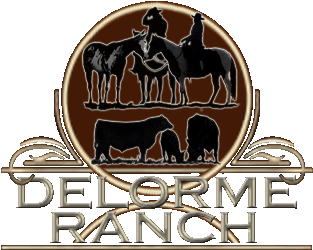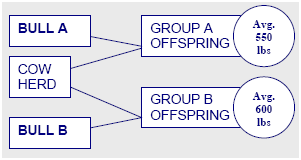

Check out our other sale features: Bred Heifers | Replacement Heifers | Feeder Steers | Horses | Bulls For Sale




Don and Connie Delorme & Families S Box 28, Robsart, Saskatchewan S0N 2G0 ~ Canada S Phone: ( 306 ) 299 - 4494 S Email
APHA, AQHA, South Shadow Angus + Paints, Delorme Livestock, SSAP Paint & Quarter Horses, southshadow.com, DelormeLivestock.com, PaintHorses.ca, DelormeAngus.ca, southshadowangus.ca
Visitors and Inquiries Always Welcome
Give us a call and stop by for a tour and visit.
Please do not hesitate to CONTACT US if you have further questions concerning the bulls or our program.
Registered Black Angus Cattle s South Shadow Angus
Delorme Ranch s South Shadow Angus, Paint & Quarter Horses
Registered & Commercial Black Angus Cattle
Compliments of South Shadow Angus
Reprinted with permission from the
If beef is your business
Angus is your breed.


Breed Development — Using EPDs
How To Read EPDs:
EPD's are a measure of the expected differences in performance of a sire's/dam's progeny when compared to the average progeny of all sires/dams evaluated within the same breed. This prediction is based on actual performance, progeny performance and relatives' performance.
The Expected Progeny Differences (EPDs) of all the cattle on this site are listed beneath the pedigree information. These values are expressed in plus (+) or minus (-) units of measure for the trait. For example, birth weight (BW), weaning weight (WW) and yearling weight (YW) EPDs are given in plus or minus pounds. Maternal Milk (MILK) EPD's are expressed as pounds of weaning weight.
Angus Carcass EPDs are used to give breeders the EPDs necessary to select for directional change in body composition (percent retail product) and/or quality (marbling) in progeny carcasses.
ACCURACY (Acc): The reliability that can be placed on an EPD. The amount of change expected will be decreased the closer the Acc. is to 1.0.
BIRTH WEIGHT (BW): The birth weights of a bull's/cow's progeny when compared to the breed average, in pounds.
YEARLING WEIGHT (YW): The adjusted yearling weights of a bull's/cow's progeny when compared to the breed average, in pounds.
WEANING WEIGHT (WW): The adjusted weaning weights of a bull's/cow's progeny when compared to the breed average, in pounds.
SCROTAL CIRCUMFERENCE (SC): The adjusted yearling scrotal circumferences of a bull's/cow's progeny when compared to the breed average, in centimeters.
MILK: A measure of the amount of pre-weaning performance gained by calves which can be attributed to the milking ability of a bull's/cow's daughters. The EPD is expressed in pounds of calf.
TOTAL MATERNAL (TM): The expected overall difference (lb) in weaning weight of calves out of a bull's daughters compared to calves from daughters of a bull with a zero EPD for total maternal. The total materanl EPD is a measure of both growth and milking ability and is an indication of the size of calf a bull's daughter will wean. The maternal milk EPD is combined with half of the weaning growth EPD to produce the total maternal EPD. This is a prediction of the total genetic influence that a sire will have on his daughter's progeny.
YEARLING GAIN (YG): The yearling gain indicates the ability of his calves to grow between 205 days of age (weaning) and 365 days of age (yearling)
CARCASS WEIGHT (CW): carcass weight is a good predictor of total retail product. In general, carcass weight is not a good predictor of percent retail product. Selecting sires/dams with the higher EPD for carcass weight will result in progeny carcasses that produce more total retail product at constant fat and age end points. An industry target weight range for carcasses would be between 650 and 850 pounds. As with any trait, you need to be cautious of selecting for extremes unless these are necessary for you program.
MARBLING SCORE (MB): The marbling score EPD can be used to select sires/dams that will produce progeny with more marbling at a constant fat and age end point. The higher the marbling score EPD, the higher the amount of intramuscular fat in the ribeye. It should be noted that the genetic correlation between the marbling score and external backfat at the 12th rib is nearly zero. This means that breeders can select for increased, external fat when taking animals to an age-constant end point.
RIBEYE AREA (REA): The cross-sectional area of the longissimus dorsi muscle (ribeye area) at the 12th rib has been shown to account for a significant amount of variation in percent retail product at a constant carcass weight end point. This means that given two sires/dams with the higher EPD for ribeye area will have progeny that yield higher percentages of retail product. Do not use the ratio of ribeye area EPD to carcass weight EPD as a selection index nor as an indicator of differences in percent retail product or muscling.
FAT THICKNESS (FAT): the 12th rib fat thickness heritablility has been estimated to be .25 traits, from the Angus carcass database.
PERCENT RETAIL PRODUCT (%RP): This EPD is expressed in percent, combining traditional carcass traitshot carcass weight, fat thickness, ribeye area and kidney-pelvic-heart fat. The formula for percent retail product is heavily influenced by fat thickness.
Additional facts to remember about EPDs are:
- EPDs are the best overall prediction of progeny performance and are useful tools that aid in selection.
- EPDs can be used to compare bulls/cows from different herds.
- EPDs cannot be used to compare bulls/cows of different breeds.
- EPD's on non-parent bulls/cows allow valid comparisons before progeny records are available.
- EPDs on non-parents are calculated using pedigree information and individual records, if available.
- A pedigree estimated EPD (PE) is the average of two parental EPD values (½ sire, ½ dam)
HOW TO USE EPDs
EPDs are useful tools when planning breeding programs. Attention should be paid to the heritability and correlations to the traits a breeder wants to improve upon within the herd. Some traits are more heritable than others resulting in faster progress being made in comparison to other less heritable traits. Also, many traits are correlated, wherein the trait is affected by the expression of several other traits. It is important to be aware of such logistics when developing selection criteria in a breeding program.
On this page :
Expected Progeny Differences (EPDs) are the most powerful genetic tool we have for selecting the best animals for your breeding program.
EPDs are values that predict how the future progeny of an animal will perform relative to the progeny of other animals in the same breed. They are expressed in the units of that particular trait. For example, weaning weight is measured in pounds thus the Weaning Weight EPD is expressed in pounds. Another way to look at it is EPDs measure an animal’s value as a parent.
EPDs are based on pedigree information and performance data such as weight information and are then compared to other animals within a contemporary group. The different traits are adjusted to a standard age to ensure that all animals are equal when they are compared. The traits are adjusted as follows:
- 205 days of age for weaning weight
- 365 days of age for yearling weight
- 365 days of age for bulls in ultrasound
- 390 days of age for heifers in ultrasound
EPDs are then calculated using complex statistical procedures twice each year during the National Cattle Evaluation (NCE).
To ensure that your animals receive EPDs you must:
1. Be enrolled in the Canadian Angus Performance Program (CAPP).
2. Submit weaning weights on all of your animals.
3. Place your animals in a (same sex) contemporary group of more than two.
4. Ensure your animals are within the acceptable age ranges:
5. Animals that are in a management group of their own, such as twins, fosters, ET calves and lone bull calves are automatically placed into a single animal contemporary group and will not receive EPDs until they are parents to performance-recorded progeny.
Understanding the heritability and the effects of correlation between traits will aid in developing a genetic selection program that will optimize improvement on desired traits while minimizing undesirable side effects.
Each individual breeder must set his own selection goals based on the needs of his operation, the situation for that trait in his herd, and his production environment.

How To Use EPDs in Sire Selection
It would be easier if we could assume that the highest EPDs are the best. Unfortunately, it isn’t that simple. Like most decisions, using EPDs for sire selection involves tradeoffs. For example, bulls with high growth EPDs may sire calves with a higher birth weight as well. And there may be other impacts on your operation to consider.
For example, when breeding heifers it is desirable to produce calves with lower birth weights, so a breeder may want to pay special attention to birth weight EPDs of prospective bulls. If all calves were sold as feeders, the milk EPD would generally not rate much attention. Yearling weight will be important if you want to ensure finished steers in the appropriate weight range.
It should also be kept in mind that reaction to selection can differ from trait to trait. This is because some traits have higher heritability than others, and are more easily passed to offspring. For instance growth traits such as weaning weight respond faster to selection, than reproductive traits such as age at first calving.
A balance of traits is required, and the perfect balance for you will depend on your climate, nutritional and economic environment, as well as the management goals you have set for your herd.
One way to select for several traits is to set minimum and maximum acceptable levels for each trait, and then choose sires that meet the criteria. Another method would be to rank all sires on each trait, then develop a weighted index which ranks each bull from one (most desirable) to five (least desirable) for each trait. The bull with the lowest total score would be your first choice.

A Sample Sire Summary Evaluation
Producer 1 is looking for a sire that can be used on heifers; he wants a bull that will produce low birth weights and he wants to keep some heifer calves as replacements. Growth performance is not his first priority. The sire that fits his needs is sire D. He has a low birth weight EPD and above-average milk EPD.
Producer 2 has a sound breeding program; he is looking for a sire that will maintain performance and milking ability. He will select a bull that will increase growth performance and milk while maintaining calving ease. Sire B is his choice.
Producer 3 has a herd of above-average-frame cows and is not planning on keeping heifers as replacements. She is looking for a bull that will give her the most profit at weaning. Sire A will give her the best result in weaning weight. If heifers are kept as replacements, they will, on average, be inferior for maternal milk.
Producer 4 wants to maintain his calving performance and growth performance but would like to increase the milking ability in his females. Sire C is his choice.
EPDs are the most powerful genetic tool we have for selecting the best animals for your breeding program.
Commercial buyers rely on EPDs to make their purchasing decisions. Producers that do not have EPDs for their animals often lose out on selling their animals because of this. Buying an animal with EPDs provides a genetic snapshot of an animal’s breeding potential. While appearance and pedigree should be considered, EPDs allow a fair comparison of breeding value by removing environmental bias such as climate, feed and special management.
Depending on your target market, you can improve your herd by selecting for the right traits. Choosing a bull with high growth EPDs, in particular the weaning weight EPD, means more pounds at sale time. Looking at the EPDs of a prospective bull is essentially just as important as looking at specifications of an engine when buying farm machinery or vehicles.
To evaluate seedstock, use a combination of EPDs, pedigree and visual assessment. With EPDs, the concept of “intermediate optimums” works best. Selection for one trait or for extremes generally results in unexpected consequences due to genetic correlation. For example, intense selection for high yearling weight will also increase birth weight. Successful cattle breeding requires a thoughtful and balanced approach to optimize fertility, growth and carcass merit while improving profitability and efficiency. EPDs are the best tool we currently have to compare animals between herds and countries.
The quality of your EPDs also reflects the quality of data that comes into the office. Taking pride in your paperwork increases error-free data entry. Submitting your data on time or early eliminates the chances of receiving a Missing Data Report and your animals subsequently not getting EPDs due to non-compliance.
To use EPDs effectively you must understand how they work. Imagine you are interested in purchasing a couple of bulls for your herd. You are looking at the EPDs in a sale catalogue. Bull A has a weaning weight EPD of +10 and Bull B has a WW of +60. What does that mean? How can you use the EPDs to choose between the two bulls?
If these animals were randomly mated with 10 similar cows, we would expect the group average weaning weight of Bull A’s offspring to be 50 lbs lighter than that of Bull B’s (60-10=50).
In this example, if you were interested in producing heavier calves, Bull B would be the one to choose.
A note to remember, EPDs evaluate group average and offspring’s performance. They cannot predict individual performance or weights.
Another important aspect to consider when selecting animals based on their EPDs is the accuracy of those EPDs. The accuracy represents the reliability of the EPD against the true breeding value. Accuracies are reported as a percentage value. High accuracy values (greater than 0.80) mean the EPD is closer to the true breeding value than an EPD value with a lower accuracy (less than 0.20). EPDs with low accuracy have a much greater chance of changing as more information becomes available than an animal with a high accuracy EPD. Although EPDs for low accuracy animals can be considered unreliable relative to higher accuracy EPDs, they are still the best objective measure of an animal’s genetic merit.
